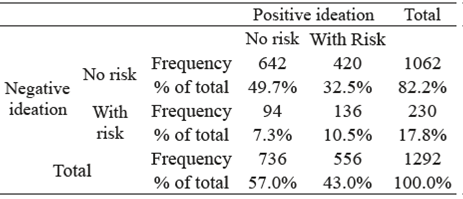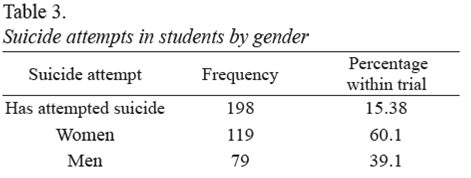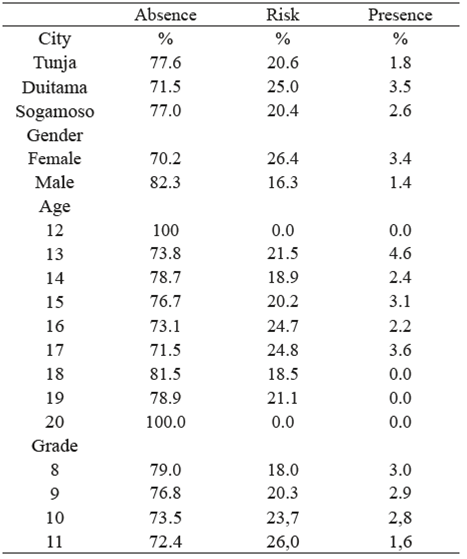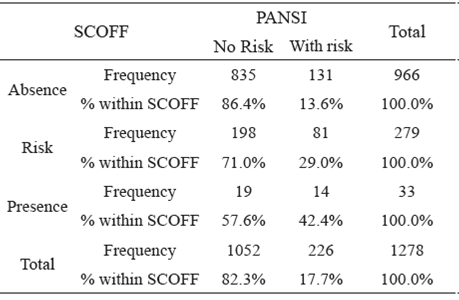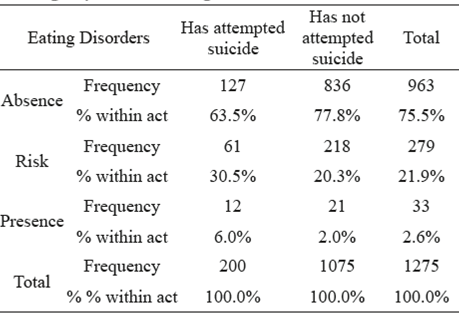INTRODUCTION
Adolescence can be understood as a period that makes possible the transition from childhood to adulthood, begins with puberty (10-12 years) and ends between 19 and 20 years of age (Galdó, 2008, Quintero & Piñeros, 2010). It is a stage in which important and rapid changes occur in the biological, psychological and social aspects. There are important tasks to carry out, as the search and consolidation of identity and the achievement of autonomy. Completion of these tasks implies the attainment of maturity and inde pendence (Gaete, 2015).
In Colombia, the Report of the National Institute of Forensic Medicine and Forensic Sciences (Forensis, 2015) has identified that Boyacá has two of the municipalities with the highest suicide rate per 100,000 inhabitants. In addition, the same report from previous years shows that this department is the second with the highest suicide rate in the country (Forensis 2012), with the adolescent population being the most vulnerable.
Regarding suicide, it is defined as an act with a fatal anticipated outcome, carried out by a person, with knowledge and purpose of obtaining a desired change (WHO, 2012). Through the accounts of young people with suicidal intent, findings show that there is a close relationship between avoiding humiliation and shameful situations and suicide attempt (Cortes, 2014). Córdoba, Cubillas and Román (2011) argue that suicidal behavior is a process that begins with the idea of committing suicide, goes through the suicide attempt until it concludes with self-inflicted death, that is, consummate suicide.
Suicidal ideation can range from thoughts of lack of appreciation for life to planning a lethal act. It can go from intense desires of death, involving cognitive and affective processes that range from feelings about the lack of sense of living and the development of plans to take one's life, to the existence of systematic and delusional concerns (Ballesteros et al., 2010; Casullo, Bonaldi & Fernández, 2000; Portilla, 2006).
Suicidal ideation occurs "when a subject persistently thinks, plans, or wishes to commit suicide, for at least two weeks, making some plan and identifying the means neces sary to achieve it" (Mingote, Jiménez, Osorio & Palomo, 2004, cited in Villalobos, 2009, p.24). On their part, Ellis (2008) and Bouquet (2010) mention that the suicide attempt is the behavior that a person displays in order to die, despite unforeseen factors that prevent the outcome.
However, this is not the only problem that young people face; for the World Health Organization-WHO- (2009) there are also behavior disorders, anxiety, depression, consumption of psychoactive substances, violent attitudes, alcoholism and eating disorders. The latter are of great interest becau se they are a growing social phenomenon, a product of a combination of psychosocial, biological, cultural, genetic, environmental and family risk factors (Alba, 2010).
The idea of the perfect body has reached its maximum level of influence, backed by the media (Internet, television and magazines) and the new aesthetic criteria imposed by society. This idea has influenced misalignment in relation to the eating habits of young people (Galarsi, Correche & Ledezma, 2010)
According to the Diagnostic and Statistical Manual of Mental Disorders DSM-V (2014), eating disorders and food intake disorders are a persistent alteration in eating-related behaviors, leading to impairment in the consumption and absorption of food and in turn cause a significant deterio ration in the physical health and in the different areas of functioning of the affected person.
It is worth mentioning that the consequences of these disorders are both physical and psychological. They are manifested in heart disease, alteration of normal mecha nisms that help control body weight, osteoporosis or loss of bone mass, malnutrition due to lack of nutrients, pre mature death, high comorbidity with social isolation, low self-esteem, intense fear of rejection or abandonment, and in more severe cases, suicide (Portela de Santana, Da Costa Ribeiro Junior, Mora Giral & Raich, 2012).
Anorexia and bulimia have expanded so rapidly in the world that they can be considered a true social epidemic (Peláez, Raich & Labrador, 2010). Risk factors for eating disorders are various, depending on the type of disorder, either for bulimia or for anorexia. However, body dissatis faction and depression are common to both. In the case of anorexia nervosa, other identified risk factors are: criticism of body shape, perfectionism, special diets, being a teenage woman, having low self-esteem and distorted perception of body image; And for bulimia nervosa, fear of gaining weight is another risk factor in addition to those already mentioned (Rutsztein, Scappatura, Murawski, 2014).
The detection and care of suicide and eating disorders is a complicated task, due to the multitude of intervening factors and the general difficulty involved in their approach. The management of these requires the formation of a team of professionals from different disciplines who work together (López & Treasure, 2011).
According to Vargas and Saavedra (2012), there have been systematic review studies to examine the association between eating disorders and suicidal phenomena, finding a significant relationship between suicide attempts and eating disorders in adolescent American women in the last year. Along these lines, for some authors suicide is the major cause of death in adolescents with eating disorders as the percentage of autoimmune death ranges from 1.8 to 7.3% (Cruzat, Ramírez, Melipillán & Marzolo, 2008; Bodell, Joiner Keel, 2013). For others, like Rodríguez, Rodríguez, Gempeler and Garzón (2013) although in people with anorexia nervosa suicide is the leading cause of death, in bulimia, the frequency of suicidal attempts is higher. Moreover, for researchers like Sánchez, Villareal, Musitu and Martínez (2010) and Forrest, et al. (2016) there is a significant relationship between eating problems and suicidal ideation and other emotional disorders such as depression.
In a study carried out with 2462 patients (95% women) admitted for eating disorders (ED) between 1995 and 2010 in the United States, 6.3% had been hospitalized for attempted suicide. The risk of suicide was found to increase by 4.7 times with the presence of anorexia nervosa (OR, 8.01, 95% CI, 5.40-11.87), and 5.08 times for bulimia nervosa (OR, 5.08; OR, 4.7; 95% CI, 1.41-15.74); 95% CI, 3.46 7.42) (Suokas et al., 2014). Similar results were reported by Suokas et al. (2013) for anorexia nervosa (OR, 5.07, 95% CI, 1.87-18.84) and bulimia nervosa (OR, 6.07, 95% CI, 2.47-14.89). In this regard, Bodell, et al. (2013), found, through a regression analysis, that bulimia nervosa signifi cantly predicts the occurrence and increase of suicidal risk and comorbid disorders. However, since anorexia nervosa was not significant, the authors suggest both to develop new studies to elucidate the causal role of bulimia nervosa and its applicability in the evaluation of suicidal risk. (Toro, Viancha, Martínez & Pérez, in press).
In a research conducted by Sánchez-Sosa et al. (2010), that studied suicidal ideation in adolescents, a direct and significant relationship between their study variables and suicidal ideation was identified. The figures found were the following: depressive symptomatology (r = .511; p = .001); (R = .271; p = .001), high-risk eating behavior, (r = .271; p = .001), victimization (r = .262; p = .001) and school adjustment problems (r = .218; p = .001). This supports the premise of suicidal ideation as a multifactorial pheno menon and therefore, future scientific research must walk in that direction.
In Colombia, studies such as those conducted by Piñeros, Molano and López de Mesa (2010) identify comorbidity between eating disorders and depressive and anxious disorders, as well as more frequent suicidal behaviors in adolescents with a clinical diagnosis of eating disorders than in those without a psychiatric diagnosis and with others disorders (p = 0.019). For those authors, these findings show the importance of assessing suicide risk and its relation to eating disorders in young people.
In addition, in the department of Boyacá, the age of 15 years is the one in which there is greater presence of sui cide attempts. This age is also critical for the development of eating disorders (Carmona, Arango, Castaño, Escobar, García & Godoy, 2010). In addition, taking into account the current increase in the number of suicides and eating disorders, these two can be considered serious public health problems (Fandiño, Giraldo, Martínez, Aux & Espinosa, 2007 Manrique, Barrera & Ospina, 2006).
This situation justifies the present study, in which the general objective was to establish if there is an association between eating disorders and suicidal behavior in school children in Boyacá, Colombia.
METHOD
Type of study
The study was selective probabilistic, cross-sectional, fra med within a descriptive strategy (Ato, López & Benavente, 2013). It is correlational as its purpose was to identify the relationship between symptoms of eating disorders and suicidal behavior in young people (Hernández, Fernández & Baptista, 2010). The authors present original empirical data elaborated by them and framed within the epistemolo-gical logic of objectivist tradition (Montero & León, 2007).
Participants
A stratified probabilistic sampling was selected (Hernández, Fernández & Baptista, 2010), where the stra tification variables were: city, educational institution and grade level. The values used were the following: N = 85444, p = 0.13, q = 0.87, Z = 2.576, e = 0.05. The sample size was 1500 students and after having selected the appropriately completed questionnaires, the sample was made of 1292 students, grades eighth to eleventh, of secondary education institutions in the cities of Tunja, Duitama and Sogamoso in the department of Boyacá (Colombia). Inclusion criteria taken into account were voluntary participation and signa ture of informed consents. Population was homogeneous, consisting of 710 women (55.03%) and 582 men (44.96%). The age range of participants was between 12 and 20 years, with an average of 15.4 years of age (SD = 1.35).
Instruments
Socio-demographic questionnaire.
An instrument developed by the researchers, which consists of six questions of nominal and ordinal nature that allow inquiring about sociodemographic variables (sex, age, grade, type of family, city and name of the school).
Sick Control on Fat Food Questionnaire (SCOFF).
This test consists of five questions that address the fundamental nucleus of bulimia and anorexia. Its name derives from the acronym of the English words of each question (Morgan, Reid & Lacey, 1999). The question naire has a sensitivity of 100% (CI 95% 96,9%-100%), a specificity of 87% (95% CI, 79.2% - 93.4%) in the English population, and was validated in Colombia in the city of Bucaramanga (Rueda, 2005). The scores between 0 and 1 indicate absence, between 2 and 3 indicate risk, and between 4 and 5 indicate presence.
Positive andNegative Suicidal Ideation (PANSI) Inventory of Positive and Negative Suicidal Ideation.
This instrument was adapted by means of the simple translation technique. The PANSI (Osman et al., 1998) is a questionnaire of 14 items, 6 of the positive suicidal ideation (protective factors) and 8 of negative suicidal ideation (risk factors) evaluated within the last two weeks and asking how often the person has presented each of the 14 thoughts. The person must respond using a 4 points scale ranging from 0 (never) to 4 (always). The cut-off point for the Positive suicidal ideation scale was 18, where lower values indicate the presence of risk and higher values, the absence of risk. In the Negative suicidal ideation scale, the cut-off point was 16, so that lower values show Suicidal Risk and higher values, the absence of Risk. This inventory has shown coefficients of internal consistency above 0.8 and adequate evidence of construct validity (concurrent and discriminant) in both clinical and non-clinical samples (Osman et al., 2003).
Once the instruments were completed, the database was prepared and the results obtained were analyzed using descriptive statistics such as frequencies, means, medians, modes and standard deviations. Later, the associations between the variables were performed according to the nominal character of the same.
Procedure
The secretaries of education, principals and coordina tors of public schools of the three cities were contacted to request authorization to carry out the study. In each of the institutions, the number of participants per grade (8th, 9th,10th,11th) was indicated according to the sampling done, and the participating students were randomly selected. Then informed consents were sent to the parents for them to complete and deliver on the day of instrument application. Students were explained the purpose of the study and the way the information provided would be used. On the day of the application, they were informed about the adequate completion of the instrument, which began with the so-ciodemographic data, then the PANSI and ended with the SCOFF Test. The application was carried out in a group way and completion of the inventory was individual; on average, such application had a duration of 60 minutes. Results were analyzed with SPSS Software version 20.
Ethical considerations and criteria
Authorization was requested to the Directors of Public Schools and an informed consent was given to parents and participants. The entire investigative procedure was in accor dance with the Colombian legislation in force, Resolution number 8430 of 1993 (Ministry of National Health, 1993) and Law 1090 of 2006 (Constitutional Court, 2006) which dictate the norms for health research and the practice of research in psychology. The approval of the Institutional Bioethics Committee was also obtained. There were no conflicts of interest.
RESULTS
The following data show the presence of ideation, sui cidal act and eating disorders in the participating sample, as well as the associations found between these variables.
Suicidal Ideation
The results show that of the 1292 youngsters, 43% (556) showed absence of positive suicidal ideation, i.e. low scores on protective factors (See Table 1).
Table 1 Presence of positive suicidal ideation in the total sample
| Frequency | Percentage | |
| No risk | 736 | 57% |
| With risk | 556 | 43% |
| Total | 1292 | 100 % |
The results presented in table 2 show that of the total of young people who participated in the study, 230 think of suicide as an alternative, that is, 17.8%; but out of this total, 136, corresponding to 10.5% of the sample, do not have protective factors that allow them to cope with adverse situations (see Table 2).
Suicide Attempt
Of the 1287 young people who answered the question "Have you ever tried to commit suicide" 15.38% (198 students) state that they have done so, a fact that is relevant (see Table 3).
Symptoms of eating disorders
Scores between 2 and 3 were considered a "risk" that indicated the occurrence of some behaviors related to eating disorders, and the denomination "Presence" was assigned to scores between 4 and 5, which indicated the manifesta tion of behaviors characteristic of eating disorders. 2.6% (33 students) of the total sample showed indicators for a possible eating disorder of anorexia and bulimia; 21.6% (279 students) may be at risk for bulimia or anorexia, with the female population scoring higher frequencies.
The highest risk and presence of eating disorders is found in the city of Duitama (28.5%), in the female population (28.5%), 17 years' old (28.4%), eleventh grade (27.6%) (See Table 4).
Suicidal ideation and eating disorders
To identify eating disorders, the SCOFF questionnaire was applied, which allows a risk screening on the develo pment of an eating disorder, but does not identify the type of specific disorder exhibited by the person. The results presented in Table 5 establish that of the 33 students who evidence an eating disorder, 14 of them (42.4%) also present suicidal ideation.
The chi2 score was 49.8 and the bilateral sig had a result of 0.00. These results indicate a significant association between eating disorders and suicidal ideation.
As shown in Table 5, 42.4% of those with symptoms related to eating disorders have a negative suicidal ideation (risk); in addition, 81 students who constitute 29.0% of the youth at risk ofhaving an eating disorder, have negative ideas.
Suicide intent and eating disorders
As shown in Table 6, 6.0% of those who report symp toms related to eating disorders, report having attempted suicide too. Likewise, 30.5% of young people at risk of developing an eating disorder claim to have attempted suicide. A chi2 score of 23,263 and a bilateral sig of 0.00 indicate a significant association between eating disorders and suicidal intention.
Through the Spearman r coefficient, the correlation bet ween the total of the SCOFF evaluating the eating disorders and the two PANSI scales totals (positive and negative) was established. A low but significant correlation was found between eating disorders and PANSI Negative, the rs score was = .19 with a p = 0.00 value, which indicates that the higher the presence of alarm signals of eating disorders, the more risk factors for suicidal ideation
DISCUSSION
The results indicate a relationship between eating di sorders, and suicidal ideation and intent; 230 participants, equivalent to 17.8% of the total sample, presented risk of negative suicidal ideation (risk factors). This risk is related to failure, hopelessness, low self-efficacy, low self-esteem, frustration, sadness and difficulty in problems resolution. It is also related to non-adaptive coping strategies focused on emotion, with a tendency to self-blame and concerning life experiences to which teens can be exposed in daily life (Kirchner, Ferrer, Forns & Zanini, 2011; Miranda, Cubillas, Román & Abril, 2009; Montes & Montes 2009; Quintanilla, Valadez, Valencia & González, 2005; Villalobos, 2009,).
Based on the results of this study, it should be noted that of the 1292 youngsters, 43%, corresponding to 556 participants, is vulnerable to suicide, a finding that corrobo rates conclusions from other studies indicating that suicidal ideation is a predictor of suicide risk (Cabra, Infante & Sossa, 2010; Cano, Gutiérrez & Nizama, 2009; Córdova, Estrada, & Velázquez, 2013).
According to Estruch and Cardús (1982), the reasons or causes why an individual tries to commit suicide can be so varied and different, that to explain them in their totality would be too arduous, since suicide is a multicausal pro blematic. However, they mention there is a link between suicide and eating disorders, an aspect that confirms the results presented in this research.
As for the variable gender, according to the Forensis Report (2015), in Colombia, women, in greater proportion than men, try to commit suicide, but men are the most lethal. By 2015, 1,655 men, or 80.03% of the population committed suicide. Regarding the total number of suicides, while the number of cases in women was much lower, with 413 cases, data validate the findings of this research, since 60.1% of those who attempted to commit suicide were female, and the remaining 39.9% were male.
The information collected with the SCOFF questionnaire indicates that 2.6%, equivalent to 33 adolescents shows indicators of a possible eating disorder; while 21.9%, co rresponding to 279 youngsters, may be at risk for bulimia or anorexia, being the female population the one registering the highest frequencies. According to the studies by Kiefer, Leitner, Bauer and Rieder (2000), women tend to steer their own perception towards the pattern of social beauty and are more influenced than men are by the idea of being skinny. Therefore, they are more often dissatisfied with their weight and perceive themselves as considerably heavier than they are. These factors, together with the excessive attention given to body image and weight, are risk factors for the development of an eating disorder.
This study corroborates that females present higher percentages of symptoms of eating disorders; 26.4% of the participants are at risk, and 3.4% present this problem. For males, these percentages correspond to 16.3% and 1.4%, respectively. These results confirm the assertions made by authors like Sherman and Thompson (2005), who identify women as the main victims of eating disorders, since society, in the visual and printed media, contributes to the concern for slenderness and to perceive success and happiness as consequences of figure (Cano et al., 2007, Nuño, Celis & Unikel, 2009, Sánchez, Guzmán & Cáceres, 2005).
Suffering from eating disorders and having suicidal behaviors have also been associated with personality characteristics or disorders (Borrego, 2010; Galarsi, et al., 2010), an aspect that was not evaluated in this research, but that should be considered in future studies in order to obtain more information and establish possible relationships between these variables.
Suicidal intent and suicidal ideation are indistinctly common in women with eating disorders and with depres sion (García-Valencia, et al., 2008; Medina, Piernagorda & Rengifo, 2010). In clinical population, for example, self-injury and its different forms, such as eating disorders, correlate with suicide (Negredo, Melis & Herrero, 2011). The results of this investigation show that, although the population under study was not clinical, a significant as sociation between eating disorders and suicidal ideation and attempt was found too, an indicator that highlights the need to deepen this aspect to prevent suicidal behavior in young people.
In this sense, it is important to affirm that suicidal intent and eating disorders directly or indirectly constitute self-injurious behaviors: direct ones such as skin cuts, severe nail biting or beating, among others; and indirect, such as alcoholism, dangerous driving, smoking, drug addiction and eating disorders (Zannety, Santonastaso, Sgarabatty, Degortes & Favaro, 2013). For these authors, both eating disorders and self-injurious behaviors share important points: they are typical of women and their onset occurs during adolescence, which is confirmed by the results of the present study. In addition, they may be linked to dissatisfaction with body image and a strong sense of low self-efficacy, which often leads to self-punishment. (Zannety, Santonastaso, Sgarabatty, Degortes & Favaro, 2013).
From this perspective, the results obtained with respect to the significant and positive relationship between eating disorders and ideation and suicidal attempt support similar findings from other studies. Examples of these are the ones by Laufer (1995); Machado, Goncalves, Machado, Torres & Brandao,(2004); Rodríguez et al.(.2007); Cano et al. (2007); Cortés, Díaz, Mejía, & Mesa, (2003); Breton, Gutiérrez, Villatoro, Moreno & Gaytan (2009); Nuño et al. (2009), Sánchez-Sosa et al. (2010); Vargas and Saavedra (2012); Forrest, et al.,(2016). Thus, there is evidence of the cor respondence between these two psychological conditions and the need for further investigation.
Because of its cross-sectional nature, and the type of statistics used, this study does not give rise to conclusions that allow predicting the future behavior of young ado lescents. Therefore, it is considered pertinent that, from a differential approach (Caycedo et al., 2010), and with the support of parents, educational institutions and social or health support institutions, intervention strategies should be developed and implemented. These would be oriented to strengthening characteristics such as self-esteem, self-control and self-confidence in school- children, as well as the stability of the affective bond and support of the family, to favor protective factors against suicidal behavior and eating disorders.











 text in
text in 

